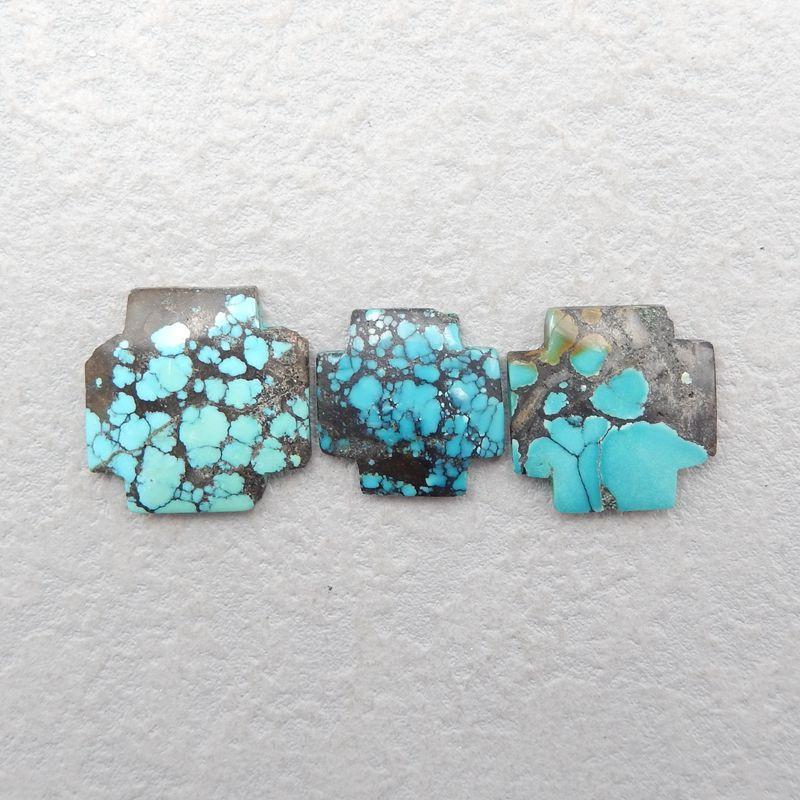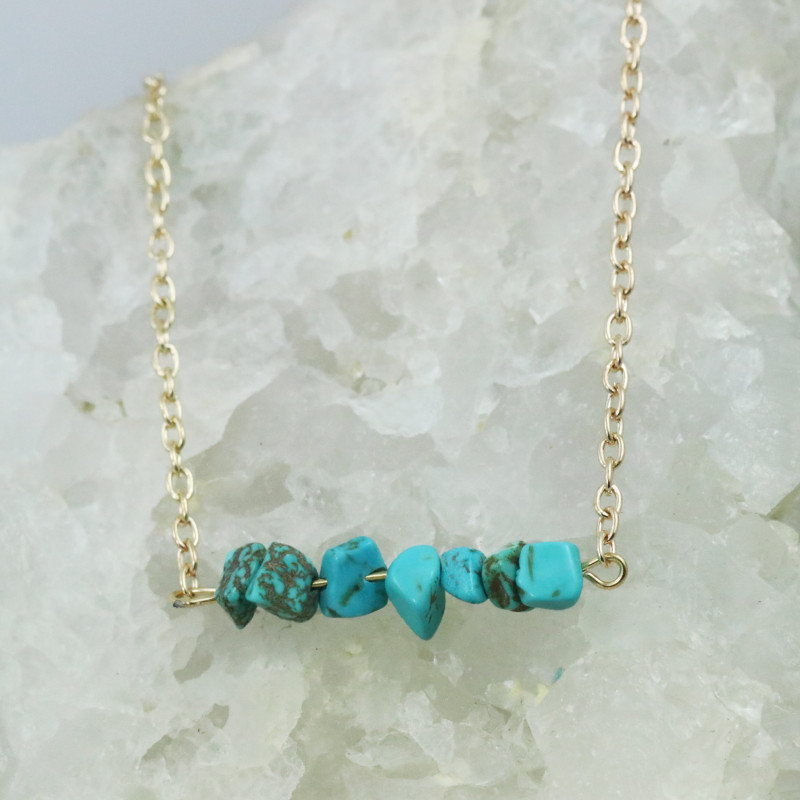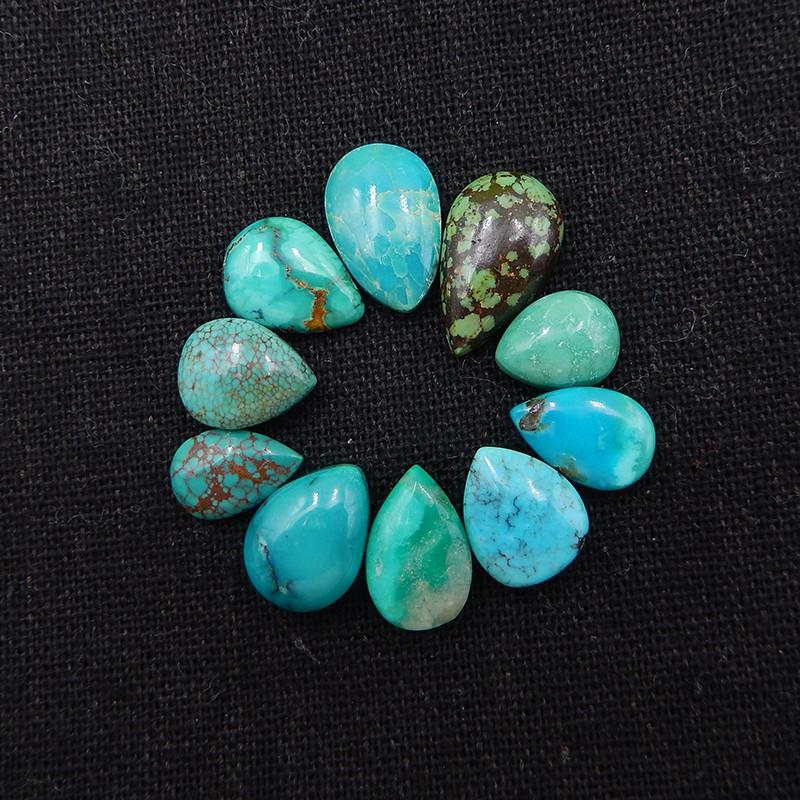
Pietra turchese: benefici, significati, proprietà e usi
 Quando si tratta della bellezza mozzafiato del mare e del cielo, le pietre turchesi sono le tue migliori amiche! Il turchese è un minerale fosfato ricco di rame e alluminio, apprezzato per le sue proprietà e i suoi usi versatili. Che tu stia cercando guarigione, protezione o bellezza, il turchese può fare tutto!
Quando si tratta della bellezza mozzafiato del mare e del cielo, le pietre turchesi sono le tue migliori amiche! Il turchese è un minerale fosfato ricco di rame e alluminio, apprezzato per le sue proprietà e i suoi usi versatili. Che tu stia cercando guarigione, protezione o bellezza, il turchese può fare tutto!
In questa guida olistica, approfondiremo le diverse caratteristiche, i significati, le proprietà curative e molto altro del turchese. Iniziamo!
Informazioni su Turquoise
Le pietre turchesi sono minerali fosfatici blu e verdi, celebri per la loro energia rilassante e la bellezza oceanica. I gioielli in turchese sono oggetto di desiderio da migliaia di anni. Che siate amanti di anelli, pendenti, perline o collane, il turchese sarà sicuramente una scelta straordinaria!
Se tu o una persona cara festeggiate il compleanno a dicembre, potete tranquillamente dichiarare il turchese come pietra portafortuna ! Le fredde tonalità blu del turchese sono perfette per tutti i bambini nati in inverno.
Allo stesso modo, se il tuo segno zodiacale è Sagittario o Capricorno, il turchese è la pietra perfetta per te. Per l'ambizioso ed entusiasta Sagittario, il turchese può aiutarti a raggiungere la prosperità. Per il forte ma spesso testardo Capricorno, il turchese può aiutarti a promuovere una comunicazione più aperta.
Parliamo di scienza per un attimo! Il turchese è un fosfato idrato ricco di rame e alluminio. Ciò significa che se lo immergi in acqua, assorbirà il liquido.
Essendo un minerale poroso, il turchese oscilla tra 5 e 6 sulla scala di Mohs, appena sotto il quarzo . Paragonato agli oggetti di uso quotidiano, il turchese è più morbido di un chiodo d'acciaio!
Approfondiamo la composizione della pietra preziosa turchese.

Specifiche e caratteristiche del turchese
Colore: turchese, blu pallido o scuro, blu-verde, giallo
Struttura cristallina: Triclina
Lucentezza: Vitrea (cristalli), cerosa o opaca (massiccia)
Trasparenza: da trasparente a traslucido (raro), opaco
Indice di rifrazione: 1,590-1,650
Peso specifico: 2,40-2,90
Scollatura: nessuna (massiccia)
Ora che abbiamo accennato alle sue proprietà chimiche, cosa simboleggia la pietra turchese?

Significato della pietra turchese
Il nome turchese deriva dal termine francese turquois, che significa "turco", del XVII secolo. Dopotutto, furono i viaggiatori turchi a introdurre per primi nell'Europa medievale le pietre turchesi provenienti dalle miniere persiane.
Il turchese è una pietra portafortuna? Scommetti! Come popolare simbolo di buona fortuna, il turchese può portare successo e fortuna. La prossima volta che cercherai una promozione al lavoro, porta con te un po' di turchese per una dose extra di fortuna.
Oltre alla buona fortuna, il turchese rappresenta anche speranza e serenità. Prova ad arredare la tua casa o il tuo ufficio con questa pietra celeste per raccogliere un po' di meritata pace e felicità. Puoi anche meditare con la tua pietra turchese, da sola o inserita in una griglia di cristallo.
Infine, il simbolismo del turchese offre protezione dai pericoli, in particolare dalla salute personale. Secondo le credenze popolari, se la tua pietra turchese si rompe, consideralo un avvertimento di pericolo! Se la tua gemma impallidisce, potresti ammalarti presto. Nel frattempo, una perdita totale di colore può indicare la morte del proprietario, ma ovviamente questo fa parte della tradizione e della leggenda della pietra.
A proposito di salute, qual è il potere curativo del turchese?

Proprietà curative del turchese
Come la maggior parte delle gemme, il turchese può essere anche una potente pietra curativa . Quali sono quindi i benefici delle pietre turchesi?
Guarigione fisica con il turchese
Rafforza il sistema immunitario
Assorbe i nutrienti
Rigenera i tessuti danneggiati
Cura gli occhi e il mal di gola
Allevia il dolore corporeo
Guarigione emozionale turchese
Combatte la depressione e la stanchezza
Previene gli attacchi di panico
Promuove l'armonia interiore
Guarigione spirituale turchese
Migliora l'autorealizzazione
Attiva i chakra del cuore, della gola e del terzo occhio
Stabilizza i chakra inferiori
Cosa sono i chakra ? I chakra sono centri energetici sacri che scorrono dalla sommità della testa alla base della colonna vertebrale.
Il chakra del cuore è il centro del tuo amore, della tua compassione e della tua empatia. Il chakra della gola controlla la tua capacità di comunicare ed esprimerti. Infine, il chakra del terzo occhio sblocca la tua intuizione e lungimiranza.
Quando i chakra sono bloccati, si può soffrire di dolore fisico e spirituale. Fortunatamente, le pietre turchesi possono aprire questi chakra e guarire dentro e fuori.
In quale altro modo le persone hanno venerato le proprietà uniche del turchese nel corso della storia?

Storia del turchese
Le società di tutto il mondo hanno apprezzato le pietre turchesi per millenni. A partire dal 3000 a.C. circa, gli antichi Egizi iniziarono a estrarre il turchese per la gioielleria e l'uso cerimoniale. Lo stesso avrebbero fatto in seguito le antiche civiltà cinese e americana.
Ricordate come il turchese possa portare fortuna? Ebbene, questa credenza risale a diversi secoli fa, in diverse culture.
Ad esempio, gli Aztechi veneravano il turchese allo stesso modo in cui altre società veneravano l'oro e lo smeraldo . Gli Aztechi usavano il turchese come offerta sacrificale alle loro divinità. Secondo la mitologia azteca, il dio Quetzalcoatl tramandò l'arte del taglio e della lucidatura del turchese.
A causa dello status speciale del turchese, i sovrani aztechi indossavano braccialetti di perline di turchese come amuleti protettivi. Dopo la morte, i capi più stimati venivano sepolti con frammenti di turchese inseriti in bocca.
In Nord America, le tribù Apache credevano che le pietre turchesi possedessero numerosi poteri mistici. Per questo motivo, gli Apache si adornavano con amuleti, perline e pendenti protettivi in turchese. Gli sciamani Apache erano considerati illegittimi se non possedevano alcun turchese.
Come accennato in precedenza, l'antica Persia (l'attuale Iran) introdusse il turchese nell'Europa medievale attraverso i viaggiatori turchi. Il turchese conobbe un'impennata di popolarità durante l'epoca vittoriana. I gioiellieri amavano incastonare la pietra nell'oro, una pratica che anche i gioiellieri moderni tendono a seguire.

Origini della pietra turchese
La maggior parte del turchese si trova in depositi nodulari e rocce ospitanti, sotto forma di vene o croste superficiali. Osservando una pietra turchese, si notano filamenti colorati simili a venature che ne corrono sulla superficie.
Conosciute come "matrici", queste vene o chiazze sono i resti della roccia ospite in cui si forma il turchese. Alcune rocce ospiti comuni includono calcedonio , opale e caolinite bianca. Le matrici possono influenzare il colore e la durevolezza di una pietra.
Il turchese è un minerale secondario . A differenza dei minerali primari, che si formano durante la cristallizzazione, i minerali secondari si formano durante successivi processi di degradazione atmosferica.
Altri minerali che spesso si trovano insieme al turchese sono la malachite e la crisocolla . Come il turchese, entrambe queste gemme presentano sfumature di blu-verde e abbondante rame.
Dove possiamo trovare il turchese nel mondo?
Fonti di turchese
Stati Uniti e Cina sono i principali fornitori mondiali di turchese. In Cina, le miniere di turchese si trovano nelle province di Hubei e Shaanxi. Le gemme di turchese cinesi hanno un colore che va dall'azzurro pallido al verde chiaro e sono solitamente più morbide rispetto alle loro controparti americane.
Negli Stati Uniti, Nevada, Arizona, Colorado e Nuovo Messico producono turchese di qualità. Il Nevada estrae più pietre preziose di turchese di tutti gli altri stati messi insieme!
Il giacimento di turchese più importante degli Stati Uniti, tuttavia, si trova a Lynch Station, in Virginia. Qui troverete l'unica fonte al mondo di cristalli di turchese trasparenti e traslucidi. Se riuscite ad accaparrarvi del turchese da questa località, avrete tra le mani un gioiello incredibilmente raro e prezioso!
In tutto il mondo, le miniere iraniane fornivano storicamente una varietà di turchese molto pregiata, chiamata "grado persiano". Le pietre di turchese di grado persiano sono di un blu celeste e non presentano matrici visibili.
Alcune miniere iraniane producono ancora oggi gemme di qualità persiana. Anche la miniera della Bella Addormentata in Arizona fornisce pietre simili.
Altre miniere di turchese nel mondo includono:
Australia
Chile
Brasile
India
Messico
Una volta che le gemme turchesi grezze sono pronte per il mercato, è il momento di andare a fare shopping di gioielli!

Proprietà della pietra preziosa turchese
Quando si acquistano gioielli in turchese di qualità, è opportuno valutare le seguenti proprietà delle pietre preziose:
Colore. I colori del turchese vanno dal turchese al blu, a volte anche al giallo. Il turchese deve le sue sfumature blu al rame, il verde al cromo e al vanadio e il giallo al ferro. Se amate i motivi a matrice, prendete in considerazione l'idea di acquistare una pietra turchese a ragnatela con una matrice nera a motivo pizzo!
Peso in carati. Le gemme di turchese sono spesso vendute a circa 4-8 carati. I gioielli più grandi sono ottimi come pezzi ornamentali.
Chiarezza. La maggior parte delle pietre turchesi sono opache, con inclusioni colorate a forma di ragnatela chiamate matrici. I motivi a matrice del turchese sono di una bellezza mozzafiato e spaziano dal nero all'oro.
Taglio. Le gemme di turchese di qualità gemma vengono solitamente intagliate in cabochon, intarsiate e intagliate . Le pietre di qualità inferiore vengono trasformate in perle, lucidate o "a pepita".
Infine, potresti prendere in considerazione le gemme turchesi sintetiche o trattate.

Trattamento e Sintetici
La maggior parte delle gemme turchesi subisce qualche tipo di trattamento prima di essere immessa sul mercato. I trattamenti sulle pietre preziose sono procedure standard e del tutto sicure che esaltano il colore e la purezza di un gioiello. Per alcune gemme turchesi, ciò significa intensificare i loro colori pallidi fino a ottenere una tonalità scura e ricca.
Esiste il turchese sintetico, con o senza motivi a matrice. Le opzioni sintetiche più diffuse includono vetro, plastica e ceramica. Alcune pietre preziose naturali, come la variscite, spesso assomigliano al turchese e possono fungere da alternative.
La Pierre Gilson Company creò il turchese sintetico più famoso nel 1972. A differenza di molti altri sintetici, queste gemme di turchese artificiale sono quasi indistinguibili dalle loro controparti naturali. Tuttavia, confrontando le due varietà al microscopio, si scopre che il turchese naturale ha una superficie liscia, mentre il turchese Pierre Gilson ha una consistenza simile alla farina d'avena.
Quando fai shopping, tieni presente che molte pietre preziose turchesi potrebbero non essere affatto turchesi! Potrebbero invece essere altri minerali o oggetti semplicemente color turchese.
Ad esempio, howlite e magnesite sono spesso tinte di blu per imitare il turchese: assicuratevi di tenerle d'occhio! Verificate sempre con il venditore e leggete attentamente le descrizioni dei prodotti.
A proposito di attenzione, scopriamo come possiamo prenderci cura al meglio dei nostri gioielli in turchese.

Cura e manutenzione del turchese
Trattandosi di una pietra piuttosto delicata, è necessario dedicare alle tue pietre turchesi un'attenzione e una cura particolari!
Detto questo, assicuratevi di conservare i vostri gioielli con turchese per un uso occasionale. Se state pensando di acquistare un anello con turchese, non dimenticate di includere delle montature protettive per preservare i vostri gioielli. Conservate il turchese in un contenitore foderato in tessuto, lontano da altre pietre preziose, per evitare graffi.
Un altro aspetto fondamentale da considerare è che il turchese assorbe liquidi e gas molto rapidamente. Ecco perché dovresti tenere i tuoi gioielli lontano da fonti di calore e sostanze chimiche. Vorrai evitare danni irreversibili!
Quando si tratta di pulire le pietre turchesi, evitate saponi, detergenti e detergenti meccanici. Anche in questo caso, il turchese è altamente poroso e potrebbe assorbire queste sostanze chimiche nocive.
Invece, pulisci le tue gemme con un panno umido e asciugale con cura. Dovrai ripetere questa operazione ogni volta che indossi i tuoi gioielli per mantenerli freschi e puliti.
Abbiamo ora spiegato che tipo di gioielli in turchese acquistare e come prendersene cura. Ma quanto costa esattamente il turchese?

Prezzi e valore del turchese
Essendo una pietra preziosa popolare e apprezzata, non sorprende che il turchese possa essere molto costoso. I gioielli di alta qualità possono arrivare a costare fino a 500 dollari al carato!
Tuttavia, i prezzi del turchese offrono molta varietà e flessibilità: una vera chicca per chi ha un budget limitato! Infatti, i gioielli in turchese possono costare anche solo cinque centesimi al carato. Se cercate un prezzo più medio, potete trovare turchesi di qualità a 30-40 dollari al carato.
Cosa spiega questa fascia di prezzo così eterogenea? L'uniformità e la saturazione del colore giocano un ruolo significativo nella valutazione del turchese.
In generale, le pietre di colore più scuro sono più preziose. Le gemme turchesi verdi o blu-verdastre sono considerate meno desiderabili e quindi meno costose. (Naturalmente, se il verde è il tuo colore preferito, sentiti libero di sfoggiarlo!)
Qual è il turchese più prezioso? Molti considerano il famigerato turchese di grado persiano, di cui abbiamo parlato prima, la varietà di turchese più pregiata. Con il suo colore intenso e intenso e l'assenza di inclusioni, il turchese di grado persiano è sicuramente una preda rara!
In definitiva, qualunque sia il tuo stile o il tuo budget, troverai facilmente il gioiello turchese che fa per te. Ecco quanto è versatile il turchese!

Oggi stesso, fai tesoro del turchese!
Abbiamo condiviso tutto ciò che c'è da sapere sulle pietre turchesi: dagli antichi Egizi agli Aztechi fino alla società moderna, la storia ha dimostrato quanto sia potente e affascinante il turchese. Siete pronti ad acquistare il turchese online?
Questa serena pietra blu racchiude un intero mondo di proprietà e utilizzi magnetici. Che tu abbia bisogno di un amuleto protettivo, di un cristallo curativo, di una splendida pietra portafortuna o di un gioiello meraviglioso, il turchese è la pietra che fa per te. Basta un po' di turchese per illuminare le tue giornate!
Vuoi acquistare un turchese? Acquista subito i turchesi da Gem Rock Auctions!
Cerca il Gemstone Encyclopedia
Aste correlate
articoli Correlati
Ognuno di noi ha una pietra preziosa che corrisponde al proprio segno zodiacale. Queste pietre sono anche note come la tua Pietra Stellare. Scopri di più su queste pietre e qual è la tua Pietra Stellare.
10th May 2018
In origine, le pietre portafortuna o gemme erano associate a un segno zodiacale o al mese di nascita di un individuo. Scopri qual è la tua pietra e guarda le pietre che abbiamo in vendita.
8th Feb 2021
Esistono moltissimi strumenti sul mercato per testare una pietra preziosa, ma quali sono i principali strumenti necessari per un'analisi semplice? Diamo un'occhiata a quattro strumenti per testare le pietre preziose.
4th Mar 2020
Articoli Recenti
Le sculture in avorio di palma, chiamato anche avorio vegetale, sono un'alternativa naturale all'avorio di elefante, ricavato in modo etico dalla noce della palma sudamericana Phytelephas. Scopri tutto sull'avorio di palma in questa guida!
15th Jan 2026
Le pietre a forma di fiore di crisantemo sono meraviglie naturali caratterizzate da un motivo floreale di calcite bianca, celestina o andalusite incastonato su calcare nero o argillite.
13th Jan 2026
La pietra del sole a reticolo arcobaleno è una varietà di feldspato con tre splendidi effetti ottici dovuti alla presenza di varie inclusioni. La sua colorazione infuocata e il suo motivo a reticolo la rendono una gemma rara da collezione!
12th Jan 2026
Categorie di articoli
How To's is where you will find helpful articles from gem Rock Auctions on how to cut gemstones, select gemstones and buy gemstones.
9 Articoli





